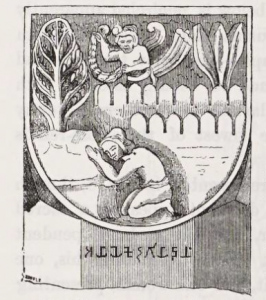
Bodhgayā (बोधगया), Bihār. Donative inscription of the noble lady Kuraṃgī (INBG0003d) on a railing pillar of vedikā (OBBG0003d). Edition here that of Tsukamoto (1996), illustration that of Fergusson (1873); see Concordance for bibliographic data.
| Metadata | |
|---|---|
| Inscription ID | INBG0003d |
| Title | Bodhgaya donative inscription of Kurangi on railing pillar |
| Alternative titles | Bodhgayā donative inscription of Kuraṃgī on railing pillar of vedikā |
| Parent Object | OBBG0003d |
| Related Inscriptions | INBG0003a INBG0003b INBG0003c INBG0001 INBG0002a INBG0002b |
| Responsibility | |
| Author | Alexander Cunningham |
| Print edition recorded by | Daniela De Simone |
| Source encoded | |
| Digitally edited by | |
| Edition improved by | |
| Authority for | |
| Metadata recorded by | Daniela De Simone |
| Authority for metadata | ERC team research |
| Metadata improved by | |
| Authoriy for improved | |
| Language | Prakrit |
| Reigning monarch | |
| Commissioner | Kuraṃgī |
| Topic | Donation of railing pillar |
| Date: | |
| Min | |
| Max | |
| Comment | The inscription is replicated on fifteen railing pillars (Barua 1934). |
| Hand | |
| Letter size | |
| Description | |
| Layout | |
| Campus: | |
| Width | |
| Height | |
| Description | Single line. |
| Decoration | |
| Bibliography | |
| References | Prinsep, J. (1836). 'Facsimiles of ancient inscriptions'. Journal of the Asiatic Society of Bengal V, p. 638, n. 5, pl. XXXIII. Prinsep, J. (1837). 'Application of the Sanchi alphabet'. Journal of the Asiatic Society of Bengal VI, part I, p. 468. Kittoe, M. (1847). 'Notes on the sculptures of Bôdh Gyah'. Journal of the Asiatic Society of Bengal XVI, part I, p. 339. Cunningham, A. (1871). ASIR 1862-63-64-65 (vol. I). Simla: Government Central Press, p. 10, pl. VII. Cunningham, A. (1873). ASIR 1871-72 (vol. III). Calcutta: Office of the Superintendent of Government Printing, pp. 88-89, pl. XXVI 1. Fergusson, J. (1873). Tree and Serpent Worship, 2nd edition. London: India Museum, p. 130, n. 24. Mitra, R. (1878). Buddha Gaya, the Hermitage of Śakya Muni. Calcutta: Bengal Secretary Press, pp. 182-183. Indraji, B. (1880). Indian Antiquary IX, p. 142. Cunningham, A. (1892). Mahâbodhi or the Great Buddhist Temple under the Bodhi Tree at Buddha-Gaya. London: W.H. Allen & Co., p. 15, pl. X 4-7. Lüders, H. (1912). A List of Brāhmi Inscriptions from the Earliest Times to about A.D. 400 with exceptions of those of Asoka. Epigraphia Indica 1909-10, vol. X, pp. 95-96, n. 939-942. Barua, B. (1934). Gayā and Buddha-Gayā, vol. II. Calcutta: Indian Research Institute, pp. 66-67. Tsukamoto, K. (1996). A Comprehensive Study of the Indian Buddhist Inscriptions, part I. Kyoto: Heirakuji-shoten, p. 137, Bodh-Gayā 3-6. |
| Add to bibliography | For a discussion on the vajrāsana and the caṅkramaṇa see: Boperachchi, O. (2016). Seven Weeks after the Buddha's Enlightenment: Contradictions in Texts, Confusions in Art. New Delhi: Manohar. Willis, M. (2016). ‘Bodhgayā: from tree to temple’, in Modes of Representing Sacred Sites in East Asian Buddhist Art. Kyoto: The Institute for Research in Humanities. De Simone, D., Balogh, D., and Bretfeld, S. (2020). 'The āsana: where the Buddha sat', in G. Hidas, S. van Schaik, D. De Simone, and M. Willis (eds.) Precious Treasures from the Diamond Throne: Finds from the Site of the Buddha’s Enlightenment. London: The British Museum Press (in press). For a discussion on the reliefs of the railing pillar see: Coomaraswamy, A.K. (1935). La Sculpture de Bodhgayā. Paris: Les Éditions d'Art et d'Histoire. Chakravarty, K.K. (1997). Early Buddhist Art of Bodh-gayā. New Delhi: Munshiram Manoharlal. |
| Misc notes | |